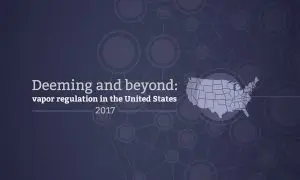 E-cigarette regulation in the U.S. is more complex than ever following the arrival of the final deeming regulations and increasing legislation at federal, state and local level. The web of regulation, heavily influenced by the frameworks put in place for tobacco products, is the subject of a new ECigIntelligence report available for download by qualified subscribers.
E-cigarette regulation in the U.S. is more complex than ever following the arrival of the final deeming regulations and increasing legislation at federal, state and local level. The web of regulation, heavily influenced by the frameworks put in place for tobacco products, is the subject of a new ECigIntelligence report available for download by qualified subscribers.
Though it has been subject to legal and legislative challenges, and in fact may still face similar challenges, the Food and Drug Administration (FDA) deeming rule, which came into effect on 8th August 2016, remains intact.
Perhaps most significant will be the requirements for product approval. New products introduced since that 2016 date must be accepted by the FDA before they can be sold, through a premarket authorisation process; and products that were already on the market on 8th August 2016 must also be submitted for authorisation by 8th August 2018.
The deeming regulations also impose other restrictions and requirements, notably on registration of manufacturers and information submission; product labelling; and aspects of sales and marketing, including sale to minors, sampling and vending.
The majority of states also introduced legislation relating to vaping last year. Their efforts have focused on particular aspects of regulation, often those not addressed at the federal level. Youth access, public vaping, product characteristics, and marketing and advertising are prominent among issues dealt with at state level.
Taxation, not covered by federal regulation, was also significant: there were 42 tax bills considered by 19 states last year.
The highly detailed ECigIntelligence report, which has also been sent in printed format to all Platinum subscribers, includes a full examination of the deeming rule and its implications as well as individual sections on each of the 50 states.







